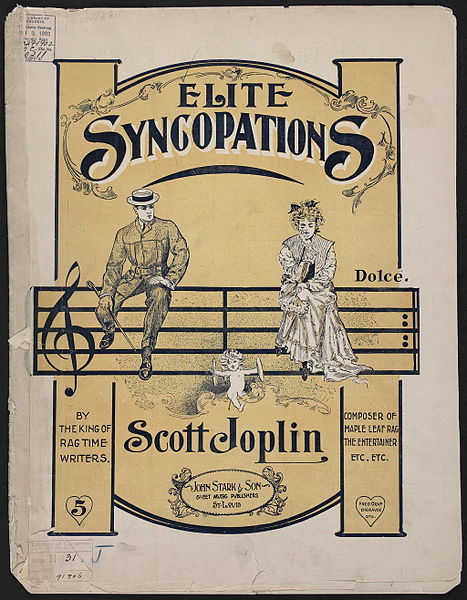Joplin, Elite Syncopations
You may know the music of Scott Joplin (c. 1868-1917) from the movie The Sting, especially if you who are old enough to remember 1973. Joshua Rifkin and William Bolcom revived Joplin’s music around 1970. But for some years before then, most people would not have known of Joplin or given much thought to the “ragtime” style.
 Ragtime juxtaposes a syncopated melody against a regular rhythm in the accompaniment. Take away the syncopated melody and you have something that closely resembles the form of a typical Sousa march. Some elements of the style occur from the time when composers combined European harmonies with African rhythms, for example in the music of Louis Moreau Gottschalk or Stephen Foster.
Ragtime juxtaposes a syncopated melody against a regular rhythm in the accompaniment. Take away the syncopated melody and you have something that closely resembles the form of a typical Sousa march. Some elements of the style occur from the time when composers combined European harmonies with African rhythms, for example in the music of Louis Moreau Gottschalk or Stephen Foster.
Ragtime reached its height of popularity between 1890 and World War I. Joplin sold over a million print copies of Maple Leaf Rag (1899). Piano rolls added to the popularity of his music. But as recorded music took over the market, jazz replaced ragtime as the predominant form of music derived from black culture. Later composers like Gershwin absorbed features of ragtime, but these compositions lacked the distinct characteristics of the style championed by Joplin and some of his contemporaries.
Unlike the largely improvisational jazz style, ragtime was created in written form. Joplin received training from a German music teacher and his scores attest to his musical knowledge. And while some may associate ragtime with flash and speed (perhaps because piano rolls can be made to play fast), Joplin’s style is refined and subtle.
Now, you may ask why the video features scenes from a stately mansion in Surrey. I have no idea, other than the fact that the pianist is a Brit and Surrey is just as good a place as any to play ragtime. Maybe Professor Carol should film there too.



